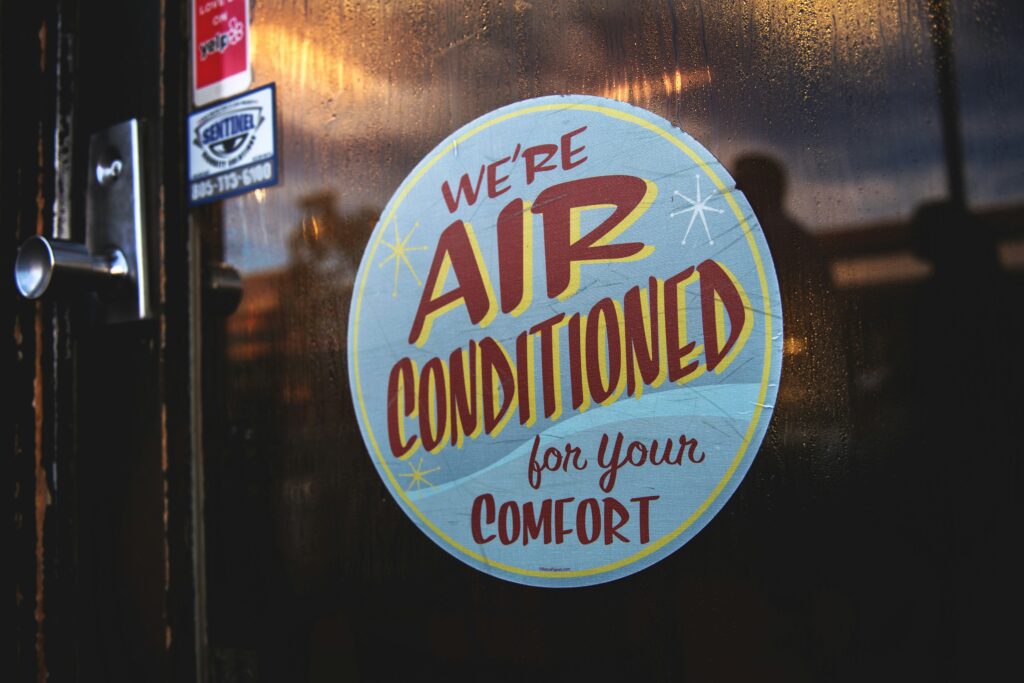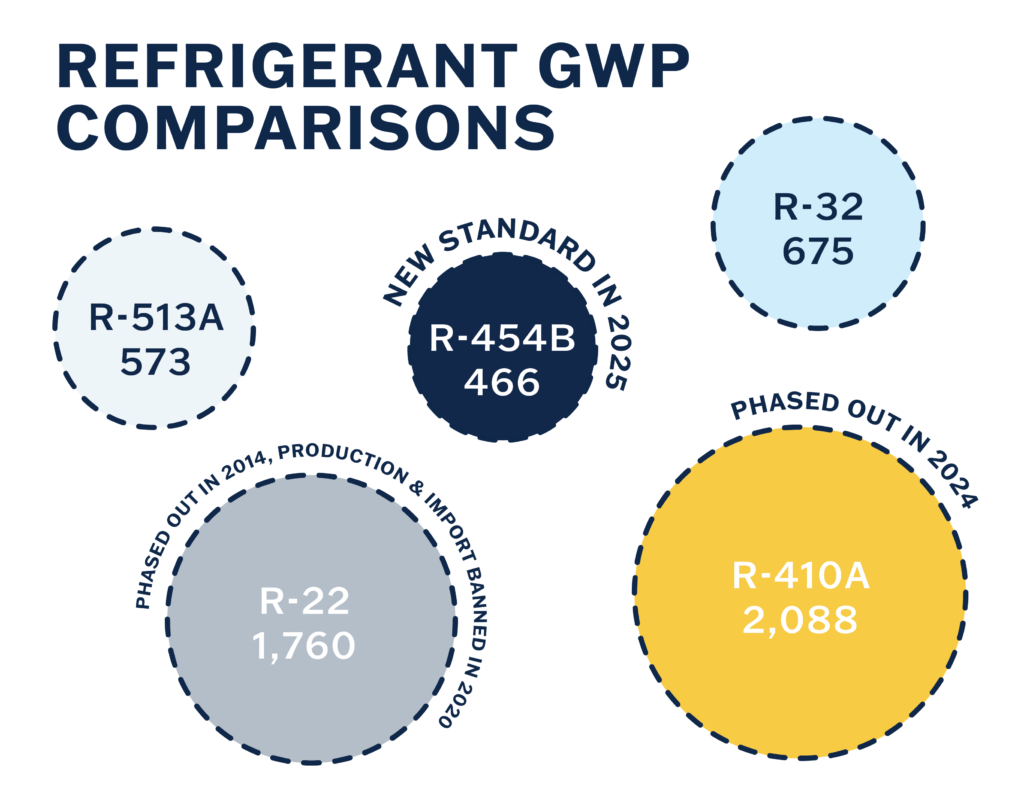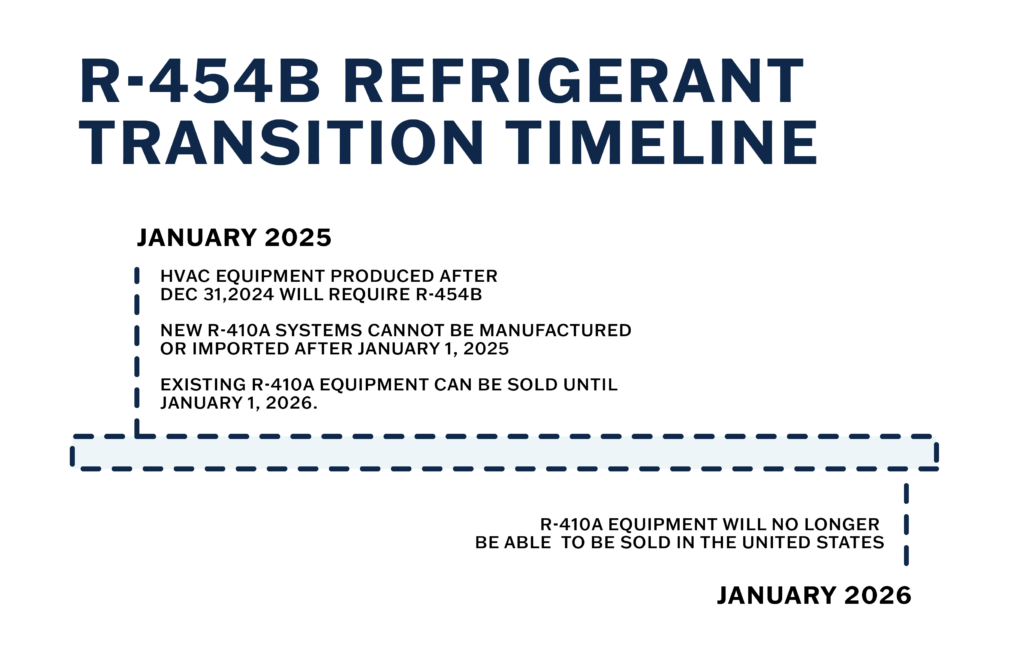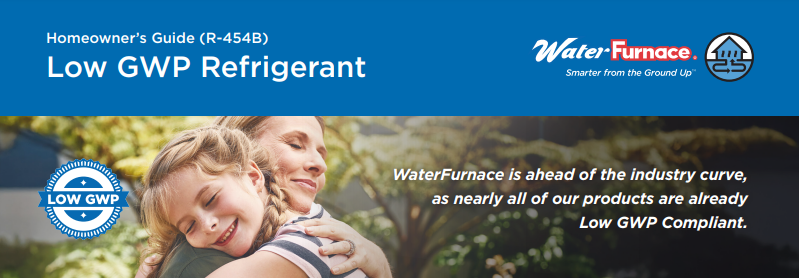
The HVAC industry has been working diligently to find refrigerant alternatives that reduce global warming potential (GWP) and ozone depletion. One of the most significant changes in 2025 has been the shift from R-410A refrigerant to R-454B. In this article, we’ll explore the key differences between these two refrigerants and why the HVAC industry is in the process of making the switch to R-454B.
What is R-410A Refrigerant?
R-410A is a synthetic refrigerant commonly used in air conditioning systems and heat pumps. Introduced in the 1990s as a replacement for R-22, R-410A quickly became the standard refrigerant for residential and commercial HVAC applications. One of the key benefits of R-410A is its high energy efficiency, which allows systems using it to perform well in a variety of climates. However, R-410A has a relatively high Global Warming Potential (GWP), which has led to growing environmental concerns.
What is R-454B Refrigerant?
R-454B is a newer refrigerant designed as a low-GWP alternative to R-410A. It is a hydrofluoro-olefin (HFO) blend, and its GWP is significantly lower than that of R-410A. R-454B is made primarily from R-32 and R-1234yf, both of which have much lower GWP values compared to older refrigerants. As a result, R-454B provides a more environmentally friendly solution without compromising performance or efficiency.
Comparing 410A and 454B: Key Differences
1. Global Warming Potential (GWP)
One of the biggest reasons the HVAC industry is making the switch from R-410A to R-454B is the drastic difference in their GWP.
- R-410A has a GWP of 2088, which means that it has the potential to trap 2088 times more heat in the atmosphere than carbon dioxide over a 100-year period.
- R-454B, on the other hand, has a GWP of 466, which is about 78% lower than R-410A.
This significant reduction in GWP aligns with global efforts to limit global warming, making R-454B the more sustainable choice.

2. Environmental Impact
While R-410A is not ozone-depleting, its high GWP contributes to climate change. In contrast, R-454B is designed to be a more environmentally friendly refrigerant with a lower impact on the atmosphere. The move to R-454B helps the HVAC industry comply with efforts to phase out high-GWP refrigerants and reduce the industry’s overall environmental impact.
3. Energy Efficiency and Performance
Both R-410A and R-454B offer excellent energy efficiency, but there are some subtle differences in performance. While R-454B has a slightly lower capacity compared to R-410A, it can still achieve comparable or even better efficiency when used in modern, high-performance systems.
Additionally, R-454B offers improved performance in high-temperature conditions, which can be beneficial in regions with extreme heat. As a result, HVAC manufacturers have designed systems that optimize R-454B’s efficiency, making it a competitive alternative to R-410A.
4. Safety and Compatibility
In terms of safety, R-454B has a lower flammability rating than some other low-GWP refrigerants, such as R-32, which gives it an edge in terms of handling and transport. It is classified as A2L, which means it is mildly flammable but poses minimal risk under normal operating conditions. R-410A, in contrast, is classified as A1, meaning it is non-flammable.
For HVAC technicians and installers, the switch to R-454B means some adjustments in handling procedures, but these systems are still relatively safe and easy to work with compared to other refrigerants.
In addition, systems that utilize R-454B refrigerants are now designed to include Refrigerant Detection Systems that must be integral and listed with the equipment. If activated, these systems will energize air circulation fans, open zone dampers and de-energize electric heat. They will also activate safety shutoff valves. These safety features have been included to vent out refrigeration if leaks occur, to reduce the risk of flammability. ASHRAE 15 Section 7.6 can be further reviewed to understand these standards.
Why is the HVAC Industry Switching from R-410A to R-454B?
1. Environmental Regulations and Compliance
As part of global efforts to curb climate change, countries around the world are implementing stricter regulations on refrigerants with high GWP. The European Union, United States, and other nations are pushing for the reduction of high-GWP refrigerants, making alternatives like R-454B essential for compliance. The switch to R-454B helps HVAC manufacturers, contractors, and building owners meet these evolving environmental standards.
2. Sustainability and Consumer Demand
There is growing demand from consumers and businesses for more environmentally responsible products. As sustainability becomes a key concern for homeowners, companies, and governments, choosing refrigerants with lower GWP is an essential part of reducing the environmental footprint of HVAC systems. R-454B helps meet this demand for eco-friendly cooling and heating solutions.
3. Future-Proofing HVAC Systems
As refrigerants like R-410A face increased scrutiny and regulatory pressure for their high GWP, the HVAC industry is looking ahead to ensure systems remain relevant and compliant. By transitioning to R-454B, manufacturers and technicians are preparing for the future, ensuring that new HVAC systems are aligned with the ongoing phase-out of high-GWP refrigerants.
R-454B Refrigerant Transition Timeline
Late 2024: HVAC manufacturers will begin implementing use of R-454B refrigerants
Existing equipment: Existing systems using R-410A can still be serviced and repaired throughout their lifespan. Be aware that availability of R-410A or other refrigerants that have been discontinued may vary and price for service can be impacted (think, supply vs. demand!)
January 1, 2025: All new air conditioners and heat pumps must use R-454B or another low-GWP refrigerant.

Conclusion: The Future of HVAC Refrigerants
The shift from R-410A to R-454B represents a critical move toward sustainability in the HVAC industry. By adopting refrigerants with lower GWP, the industry is not only improving energy efficiency but also contributing to the global fight against climate change. Although the transition requires new equipment and some adjustments in system design, the long-term environmental benefits make it a necessary step for the future.
For homeowners and businesses considering new HVAC systems, the switch to R-454B ensures you are investing in a more sustainable and future-proof solution.

To read more on WaterFurnace’s transition from 410A to 454B, check out their consumer guide here on the refrigerants! https://www.waterfurnace.com/literature/collateral/LowGWP-Overview-Consumer.pdf
COMMENTS